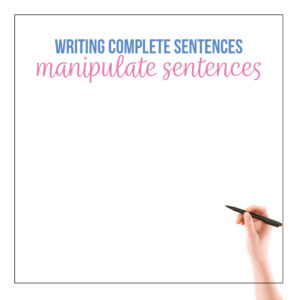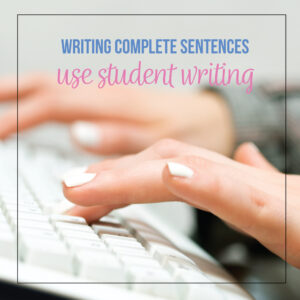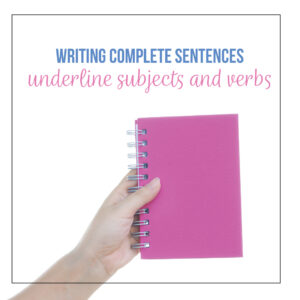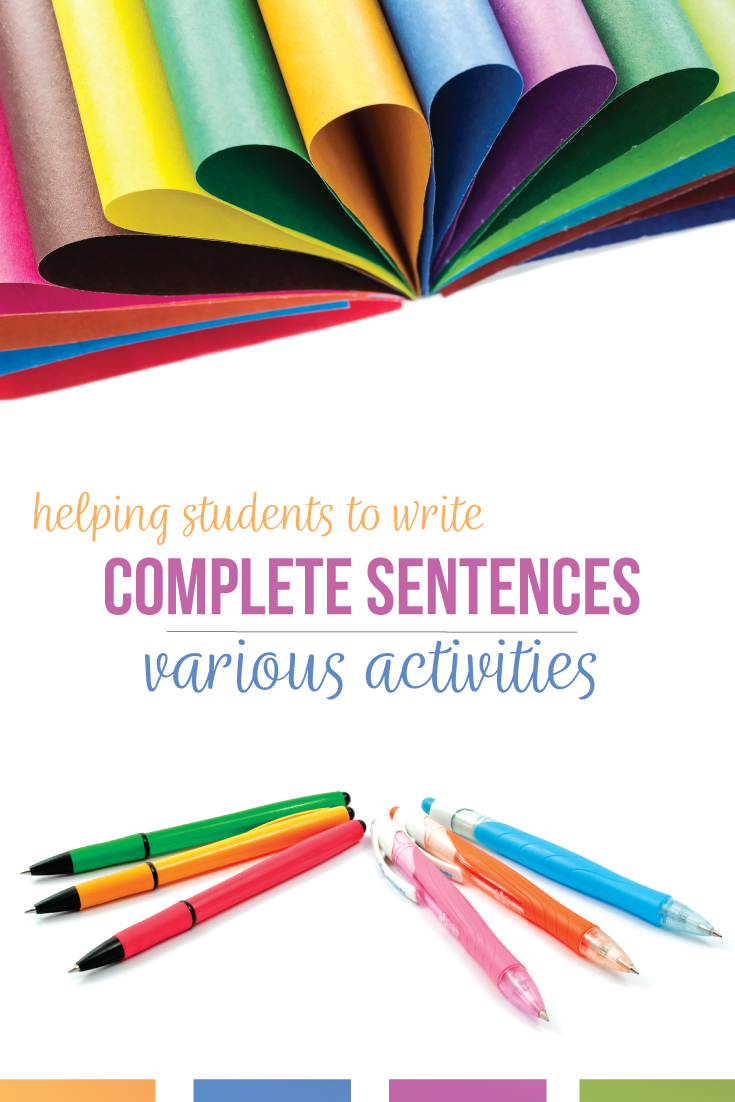Are your students struggling with writing completing sentences? In this post, I share ideas for supporting young writers and my ideas for teaching them how to write a complete sentence.
I truly believe that students possess good ideas. They might not know exactly what they want to say, and sometimes (like all of us) struggle to find the best words, and they wrestle with writing complete sentences. In an effort to turn in a paper, young writers turn in fragments, comma splices, and run on sentences. Writing incomplete sentences can sink a student essay.
Plus, if you’re working on more difficult concepts like sentence structure or parallelism, you still might face papers with incomplete sentences.
However, teaching complete sentences can can be tough. You don’t want to squash writing excitement, and you want a complete sentences lesson to be meaningful.
Do you mean sentence structure?
When I say “sentence structure,” I am normally referencing simple, compound, complex, and compound-complex sentences. We English teachers deal with sentences from question marks and linking verbs to complex punctuation pieces.
Before students can work on those structures, you might need to scaffold back to teaching complete and incomplete sentences. In this blog post, I’ll use “sentence structure” to reference complete sentences. This post aims to provide ideas for how to teach complete sentences.
What are tips tips for writing complete sentences with ELA classes?
If incomplete sentences creep into writing, I always take a break and work with young writers with several complete sentence activities. Complete sentences are the foundation of writing. Some of my approaches for helping students in writing complete sentences are below.
Manipulate sentences
Break sentences down and work on the basics: subjects and verbs. Overall, you might return to teaching complete thoughts and parts of a sentence. Grab some sticky notes and ask classes (or prep beforehand) to label nouns and verbs. Sometimes, I will color code, like using green notes for verbs.
Then, manipulate the sentences. You can do this digitally and drag boxes on a smart board. You can also move the sticky notes on a whiteboard and add direct objects or prepositional phrases. My favorite involves a bit more setup: adding words to blocks and literally building sentences. If you have a strong classroom community, students can write sentences about each other.
Silly sentences work best, but any group of subjects and verbs will work! Manipulate sentences as a refresher for what complete sentences are. As you continue, use the correct terminology with students. Using the correct vocabulary might seem like a given idea, but it is worth mentioning: use the proper domain-specific vocabulary with classes.
Look at these potential errors:
Fragments
Keeping everyone away.
That is a sentence fragment, missing its subject. Show students how grammar can work its magic.
- Add a subject and change the verb: Our guard dog keeps everyone away.
- Make that phrase modify a subject: Keeping everyone away, our dog barked at a docile passerby.
- Make that phrase a gerund phrase as the subject: Keeping everyone aways satisfies my dog.
Help classes with writing complete sentences through modeling.
Run On Sentences
The barking dog annoyed the neighbors he barked all day and night.
This is a run on sentence. Show them the multiple ways they can improve it.
- Add a semicolon: The barking dog annoyed the neighbors; he barked all day and night.
- Make one clause a dependent clause: The barking dog annoyed the neighbors because he barked all day and night.
- Turn one clause into a phrase: The dog, barking all day and night, annoyed the neighbors.
When students see grammar connect to writing in a way that they control, that they get to own, they are likely to revise and edit. Manipulate sentences in a positive way (because the process is fun!) and give them the power over their message. Teaching students about writing complete sentences can be a group process.
Pull sentences from student work
An effective complete sentence activity occurs as a class; we correct troublesome sentences together. I pull sentences from student papers. I never show student names, and I never choose something too revealing. I copy and paste the incomplete sentences into a Google Slide presentation, and we work through them together. The amount of scaffolding differs for each class. Typically, this is the most effective way for teaching complete sentences.
Sometimes, students are fine to correct the errors. Other times, we must discuss why the sentences are not complete. Other grammar lessons naturally come into play (commas, semicolons, phrases). Model questions that you ask about each incomplete sentence. New writers might not possess the internal dialogue to arrive at the correct conclusion. Verbalize what you say in your head as you read these sentences. I have even turned those questions into an anchor chart.
You can also divide students into groups or partners and assign each set a slide to fix. Not only are students working on authentic work, but they are also collaborating on writing assignments.
Another method that uses student writing is to perform the incomplete sentences. You must be comfortable with your class, but students will remember you acting out incomplete sentences:
Running through the field. (Who was running through the field? Should I run through the field? Make me the subject!)
The dog ran through the field he saw a rabbit. (That dog is doing lots of action! Could we pause him with a semicolon or period?)
A rabbit ran in front of a dog, the dog wanted to eat it. (Almost! Let’s give some more impact to those subjects and verbs. Rabbit ran and dog wanted. They each deserve their own sentence, and a comma isn’t strong enough to bring those sentences together. What would bring those ideas together best? A conjunction? A period? Why?)
I probably would pretend to be the rabbit or dog, just to get my point to students. I understand not all teachers are comfortable doing that. Try talking through writing complete sentences, giving students options along the way.
Underline each subject and verb
This activity works with individual students. I resort to this when students are frustrated or are not seeing results another way. Ask students to choose a paragraph and to highlight every subject and verb in that paragraph. This activity does not take a lengthy amount of time, especially if you circulate and work with individuals. The breakdown of a sentence in such a specific manner really helps classes visualize what their messages are. (This process also helps eliminate weak sentence structure like “there is” and “there are.”)
Ask students to highlight (digitally or with paper) the subject and verb of each sentence. Students should understand that each sentence must have at least one subject and verb for each sentence. If a sentence lacks one or the other, add one together. Use this opportunity to discuss using specific nouns (not a pronoun unless it has an antecedent) and power verbs. Lessons on writing complete sentences
Next is where time comes in: conference with students who are not finding their subjects and verbs. Students might have the components but not be able to find them, or students might not have subjects and verbs. Detailed and thorough conferences help in this situation. Once students get the “subject-verb” pattern, they will naturally add other components. As you continue to work with a class, you will glean who needs extra support.
Give targeted practice
Sometimes, students might not realize what complete sentence look like compared to incomplete sentences. Frontload the definitions and examples. (Most high school students know the definitions, but I’m sure that is not every situation.)
- A fragment is missing the sentence’s subject or verb.
- A comma splice is two sentences (two independent clauses) joined by a comma.
- A run on sentence is two or more sentences ran together.
Provide direct instruction and then apply those lessons to their writing. What I find helpful is to place side-by-side a completed worksheet and their writing with highlighted problems. Once students rework the sentences on the worksheet, they can then fix their writing.
You might sit with a student and cover one paragraph at a time. If the writing is full of incomplete sentences, start with one and model the correct process. As you work, encourage the student to share their ideas. What is typically missing from an incomplete sentence is part of the message. When a student realizes that your goal is to help them convey their ideas in the best way possible, they are more willing to focus.
With direct practice for writing complete sentences, I want grammar worksheets to matter, and that often means that I give very specific directions:
- If you have two subjects and verbs with no punctuation, you have a run on and need to add a conjunction and comma or conjunctive adverb (semicolon and comma).
- If you have two sentences joined by a comma, you have a comma splice. A comma is not strong enough to join two sentences. You can add a period (and capitalize a letter), or you can add a coordinating conjunction and a comma.
- A fragment won’t make sense. It might be part of a thought, like a phrase. It might be a dependent clause. It must make sense standing alone. What are the rest of your ideas? Supply your reader with more ideas.
Don’t simply hand students a worksheet, but reference the material and apply it to their writing. Writing complete sentences worksheets can help students, but only if the teacher I also know that correcting the work for students is tempting, and I have done that. The application of grammar to writing only works if students do the work. If you take a red pen, add a subject and verb to every fragment, and correct comma use, students will not remember how to correct incomplete sentences. They should work through the process.
As a final review, students can show their understanding with a self-grading assessment. Students typically can identify fragments, run ons, and commas splices. They simply must slow down and look at their papers. Part of teaching students tabout writing complete sentences includes rereading their creations.
Write together
Sometimes, addressing individual errors, providing direct instruction, and modeling is not enough for a writing class. You simply might write complete sentences with students with an end goal of them writing complete and simple sentences.
For example, ask students to give you a topic so that you can write separate sentences for them. (If they can’t think of a topic, write about your dog, which is what I do.) Articulate the differences for classes. For instance:
- Augie, a beagle, sleeps in my bed at night. (complete sentence with an appositive phrase)
- Augie is a beagle, he sleeps in my bed at night. (comma splice)
- Augie the beagle. (fragment)
- Augie is a snuggly boy he is adorable. (run on)
You can use a variety of topics to write sample sentences with students. I often use sentences about my life to build relationships, but doing so enables me to control what information I share. I have found that keeping the material similar helps students articulate what is different between the sentence structure.
Then, review and correct those sentences. Students might be able to recognize an incomplete sentence, but do they have tools to fix it? That’s where the beauty of a foundation of grammar helps: students get to decide how they fix each sentence.
Another method is write about the student’s topic together. Ask the student to give you the first idea, and then ask to watch you write. Trade off, modeling and helping as you write together. Throw in some compound sentences with correct punctuation marks to advance learning.
Stress the success: recognize proper punctuation, a capital letter, and great a group of words. Hopefully, you can work toward a slow release with this student.
Incomplete sentences skew a student’s ideas and overall message. I never find the struggle with young writers to be a lack of ideas. They possess interesting ideas, and we normally talk through any dead ends. Teaching students how to write a complete sentence is an ongoing conversation.
Many revision activities for older students involve a focus on clear communication. When classes struggle with complete sentences and basic sentence structure, we work on communicating our messages in the best way possible. A reader should never waste time deciphering the writer’s meaning. When I approach a student who struggles with complete sentences, I explain (that yes!) complete sentences are a grammatical necessity, an important grammar rule. Finally, teaching complete sentences can be interactive and engaging.
Sure, grammar rules are meant to be broken, but first, students must understand the rules and clearly communicate. This is never more true than with teaching complete sentences.
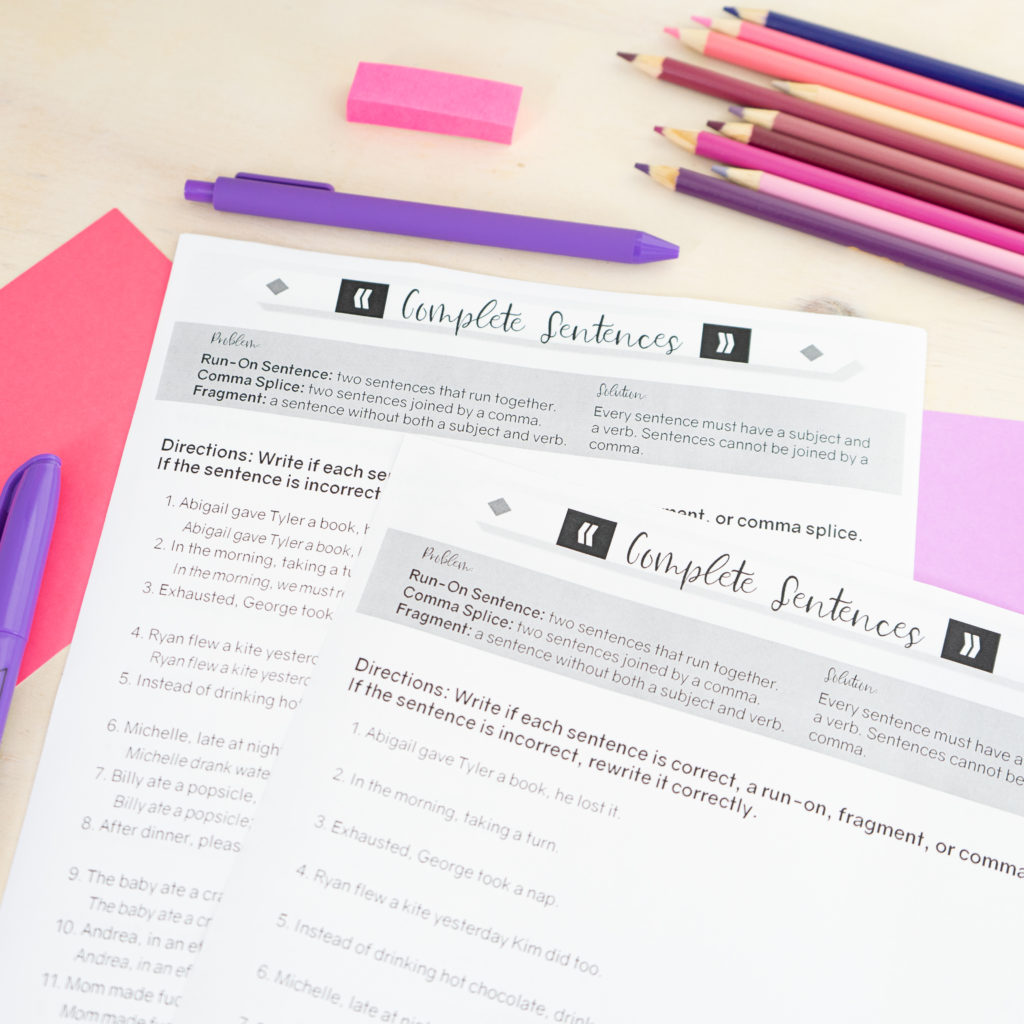
Do you need more ideas for teaching complete sentences and teaching students to write sentences? Check out Grammar Gurus, a place to discuss all ideas grammar.


